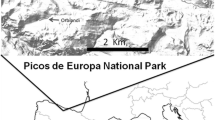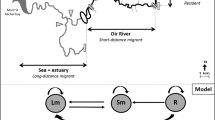Abstract
Theoretical and empirical models of populations dynamics have paid little attention to the implications of density-dependent individual growth on the persistence and regulation of small freshwater salmonid populations. We have therefore designed a study aimed at testing our hypothesis that density-dependent individual growth is a process that enhances population recovery and reduces extinction risk in salmonid populations in a variable environment subject to disturbance events. This hypothesis was tested in two newly introduced marble trout (Salmo marmoratus) populations living in Slovenian streams (Zakojska and Gorska) subject to severe autumn floods. We developed a discrete-time stochastic individual-based model of population dynamics for each population with demographic parameters and compensatory responses tightly calibrated on data from individually tagged marble trout. The occurrence of severe flood events causing population collapses was explicitly accounted for in the model. We used the model in a population viability analysis setting to estimate the quasi-extinction risk and demographic indexes of the two marble trout populations when individual growth was density-dependent. We ran a set of simulations in which the effect of floods on population abundance was explicitly accounted for and another set of simulations in which flood events were not included in the model. These simulation results were compared with those of scenarios in which individual growth was modelled with density-independent Von Bertalanffy growth curves. Our results show how density-dependent individual growth may confer remarkable resilience to marble trout populations in case of major flood events. The resilience to flood events shown by the simulation results can be explained by the increase in size-dependent fecundity as a consequence of the drop in population size after a severe flood, which allows the population to quickly recover to the pre-event conditions. Our results suggest that density-dependent individual growth plays a potentially powerful role in the persistence of freshwater salmonids living in streams subject to recurrent yet unpredictable flood events.





Similar content being viewed by others
References
Achord S, Levin PS, Zabel RW (2003) Density-dependent mortality in Pacific Salmon: the ghost of impacts past? Ecol Lett 6:335–342
Berrebi P, Povz M, Jesensek D, Crivelli AJ (2000) The genetic diversity of native, stocked and hybrid populations of Marble trout in the Soca River, Slovenia. Heredity 85:277–287
Caron J, Beaugrand JP (1988) Social and spatial structure in brook chars (Salvelinus fontinalis) under competition for food and shelter/shade. Behav Process 16:173–191
Cattaneo F, Lamouroux N, Breil P, Capra H (2002) The influence of hydrological and biotic processes on brown trout (Salmo trutta) population dynamics. Can J Fish Aquat Sci 59:12–22
Coulson T, Mace GM, Hudson E, Possingham H (2001) The use and abuse of population viability analysis. Trends Ecol Evol 16:219–221
Craig JF, Kipling C (1983) Reproductive effort versus the environment; case histories of Windemere perch, Perca fluviatilis L. and pike, Esox lucius L. J Fish Biol 22:713–727
Crivelli A, Poizat G, Berrebi P, Jesensek D, Rubin JF (2000) Conservation biology applied to fish: the example of a project for rehabilitating the marble trout (Salmo marmoratus) in Slovenia. Cybium 24:211–230
Crowley PH, Hopper KR (1994) How to behave around cannibals: a density-dependent dynamic game. Am Nat 143:117–154
Dong Q, Polis GA (1992) The dynamics of cannibalistic populations: a foraging perspective. In: Elgar MA, Crespi BJ (eds) Cannibalism: ecology and evolution among diverse taxa. Oxford University Press, New York, pp 13–37
Einum S (2005) Salmonid population dynamics: stability under weak density dependence? Oikos 110:630–633
Elliott JA (1994) Quantitative ecology and the brown trout. Oxford University press, Oxford
Elliott JM (1993) The pattern of natural mortality throughout the life-cycle in contrasting populations of brown trout, Salmo Trutta L. Fish Res 17:123–136
Elliott JM, Hurley MA, Elliott JA (1997) Variable effects of droughts on the density of a sea-trout Salmo trutta population over 30 years. J Appl Ecol 34:1229–1238
Elwood JW, Waters TF (1969) Effects of floods on food consumption and production rates of a stream brook trout population. Trans Am Fish Soc 98:253–262
Forneris G, Del Mastro GB, Bellardi S (1990) Attuale distribuzione di Salmo marmoratus Cuvier, 1817 in Provincia di Torino. Riv Idrobiol 29:213–221
Fumagalli L, Snoj A, Jesensek D, Balloux F, Jug T, Duron O, Brossier F, Crivelli AJ, Berrebi P (2002) Extreme genetic differentiation among the remnant populations of marble trout (Salmo marmoratus) in Slovenia. Mol Ecol 11:2711–2716
Grant JWA, Imre I (2005) Patterns of density dependent growth in juvenile stream-dwelling salmonids. J Fish Biol 67:100–110
Grant JWA, Steingrimsson SO, Keeley ER, Cunjak RA (1998) Implications of territory size for the measurement and prediction of salmonid abundance in streams. Can J Fish Aquat Sci 55:181–190
Grossman GD, Moyle PB, Whitaker JO (1982) Stochasticity in structural and functional-characteristics of an Indiana stream fish assemblage—a test of community theory. Am Nat 120:423–454
Grossman GD, Ratajczak RE, Crawford M, Freeman MC (1998) Assemblage organization in stream fishes: effects of environmental variation and interspecific interactions. Ecol Monogr 68:395–420
Hansen LP, Jonsson B, Morgan RIG, Thorpe JE (1989) Influence of parr maturity on emigration of smolting Atlantic salmon (Salmo salar). Can J Fish Aquat Sci 46:410–415
Harrell HL (1978) Response of the Devil’s River fish community to flooding. Copeia 1978:60–68
Hendry AP, Day T (2003) Revisiting the positive correlation between female size and egg size. Evol Ecol Res 5:421–429
Hixon MA (1980) Food production and competitor density as the determinants of feeding territory size. Am Nat 115:510–530
Hixon MA, Pacala SW, Sandin SA (2002) Population regulation: historical context and contemporary challenges of open vs. closed systems. Ecology 83:1490–1508
Hughes NF (1998) A model of habitat selection by drift-feeding stream salmonids at different scales. Ecology 79:281–294
Hutchings JA (1996) Adaptive phenotypic plasticity in brook trout, Salvelinus fontinalis, life histories. Ecoscience 3:25–32
Hutchings JA, Jones MEB (1998) Life history variation and growth rate thresholds for maturity in Atlantic salmon, Salmo salar. Can J Fish Aquat Sci 55:22–47
Jenkins TM, Diehl S, Kratz KW, Cooper SD (1999) Effects of population density on individual growth of brown trout in streams. Ecology 80:941–956
Jensen AJ, Johnsen BO (1999) The functional relationship between peak spring floods and survival and growth of juvenile Atlantic Salmon (Salmo salar) and Brown Trout (Salmo trutta). Funct Ecol 13:778–785
Keddy PA (1989) Competition. Chapman and Hall, London
Klemetsen A et al (2003) Atlantic salmon Salmo salar L., brown trout Salmo trutta L. and Arctic charr Salvelinus alpinus (L.): a review of aspects of their life histories. Ecol Freshw Fish 12:1–59
Koops MA, Hutchings JA, McIntyre TM (2004) Testing hypotheses about fecundity, body size and maternal condition in fishes. Fish Fish 5:120–130
Koslow JA (1992) Fecundity and the stock-recruitment relationship. Can J Fish Aquat Sci 49:210–217
Lake PS (2000) Disturbance, patchiness, and diversity in streams. J North Am Benthol Soc 19:573–592
Lamberti GA, Gregory SV, Ashkenas LR, Wildman RC, Moore KMS (1991) Stream ecosystem recovery following a catastrophic debris flow. Can J Fish Aquat Sci 48:196–208
Lennon RE (1961) The trout fishery in Shenandoah National Park. Special Scientific Report Fisheries 395, U.S. Fish and Wildlife Service, Washington D.C.
Letcher BH, Terrick TD (1998) Maturation of male age-0 Atlantic salmon following a massive, localized flood. J Fish Biol 53:1243–1252
Lindenmayer DB, Possingham HP (1996) Ranking conservation and timber management options for leadbeater’s possum in southeastern Australia using population viability analysis. Conserv Biol 10:235–251
Lobon-Cervia J (1996) Response of a stream fish assemblage to a severe spate in Northern Spain. Trans Am Fish Soc 125:913–919
Lobon-Cervia J, Rincon PA (2004) Environmental determinants of recruitment and their influence on the population dynamics of stream-living brown trout Salmo trutta. Oikos 105:641–646
Lorenzen K, Enberg K (2002) Density-dependent growth as a key mechanism in the regulation of fish populations: evidence from among-population comparisons. Proc R Soc Lond Ser B Biol Sci 269:49–54
Ludwig D (1999) Is it meaningful to estimate a probability of extinction? Ecology 80:298–310
Manly FJ (1997) Randomization, bootstrap and Monte Carlo methods in biology. Chapman and Hall, London
McCullagh P, Nelder JA (1989) Generalized linear models. CRC Press, Boca Raton
Meldgaard T, Crivelli AJ, Jesensek D, Poizat G, Rubin J-F, Berrebi P (2007) Hybridization mechanisms between the endangered marble trout (Salmo marmoratus) and the brown trout (Salmo trutta) as revealed by in-stream experiments. Biol Conserv 136:602–611
Milner NJ, Elliott JM, Armstrong JD, Gardiner R, Welton JS, Ladle M (2003) The natural control of salmon and trout populations in streams. Fish Res 62:111–125
Morris FM, Doak DF (2002) Quantitative conservation biology. Sinauer Assoc, Sunderland
Nikolsky J (1969) Theory of fish population dynamics as the background for rational exploitation and management of fishery resources. Oliver and Boyd, Edinburgh
Nikolsky J, Bogdanov A, Lapin Y (1973) On fecundity as a regulatory mechanism in fish population dynamics. Rapports et Proces-Verbaux des Reunions Conseil International pour l’Exploration de la Mer 164:174–177
Post JR, Parkinson EA, Johnston NT (1999) Density-dependent processes in structured fish populations: interaction strengths in whole-lake experiments. Ecol Monogr 69:155–175
Povz M, Jesensek D, Berrebi P, Crivelli AJ (1996) The Marble trout, Salmo trutta marmoratus, Cuvier 1817, in the Soca River basin, Slovenia. Tour du Valat Publication, Arles
Propst DL, Stefferud JA (1997) Population dynamics of Gila trout in the Gila River drainage of the south-western United States. J Fish Biol 51:1137–1154
Roghair CN, Dolloff CA, Underwood MK (2002) Response of a brook trout population and instream habitat to a catastrophic flood and debris flow. Trans Am Fish Soc 131:718–730
Rose KA, Cowan JH, Winemiller KO, Myers RA, Hilborn R (2001) Compensatory density dependence in fish populations: importance, controversy, understanding and prognosis. Fish Fish 2:293–327
Rothschild BJ, Fogarty MJ (1989) Spawning-stock biomass: a source of error in recruitment/stock relationships and management advice. J Conseil International pour l’Exploration de la Mer 45:131–135
Schoffmann J (1994) Zur gegenwätigen Situation des marmorierten Forelle (Salmo marmoratus Cuvier, 1817) in Albanien, ihrem südlichsten Verbreitungsraum. Osterreichs Fischerei 47:132–136
Seegrist DW, Gard R (1972) Effects of floods on trout in Sagehen Creek, California. Trans Am Fish Soc 101:478–482
Sommani E (1961) Il Salmo marmoratus Cuv.: sua origine e distribuzione nell’Italia settentrionale Bollettino di Pesca. Piscicolt Idrobiol 15:40–47
Sousa WP (1984) The role of disturbance in natural communities. Annu Rev Ecol Syst 15:353–391
Swanson BJ (1998) Autocorrelated rates of change in animal populations and their relationship to precipitation. Conserv Biol 12:801–808
Utrilla CG, Lobon-Cervia J (1999) Life-history patterns in a southern population of Atlantic salmon. J Fish Biol 55:68–83
Vincenzi S, Crivelli AJ, Jesensek D, Rubin JF, De Leo GA (2007a) Early survival of marble trout Salmo marmoratus: evidence for density dependence? Ecol Freshw Fish 16:116–123
Vincenzi S, Crivelli AJ, Jesensek D, Rubin JF, De Leo GA (2007b) Density-dependent individual growth of marble trout (Salmo marmoratus) in the Soca and Idrijca river basins, Slovenia. Hydrobiologia 583:57–68
Vincenzi S, Crivelli AJ, Jesensek D, Rubin JF, Poizat G, De Leo GA (2008) Potential factors controlling the population viability of newly introduced endangered marble trout populations. Biol Conserv 141:198–210
Weng ZY, Mookerji N, Mazumder A (2001) Nutrient-dependent recovery of Atlantic salmon streams from a catastrophic flood. Can J Fish Aquat Sci 58:1672–1682
Acknowledgments
We thank Fiorenza Micheli and Rebecca Martone for helpful comments on a first draft of the paper. We thank Foundation Sansouire and the Angling Association of Tolmin for funding this study. All of the people who participated each year to the fieldwork are warmly thanked.
Author information
Authors and Affiliations
Corresponding author
Additional information
Communicated by Marc Mangel.
Electronic supplementary material
Rights and permissions
About this article
Cite this article
Vincenzi, S., Crivelli, A.J., Jesensek, D. et al. The role of density-dependent individual growth in the persistence of freshwater salmonid populations. Oecologia 156, 523–534 (2008). https://doi.org/10.1007/s00442-008-1012-3
Received:
Accepted:
Published:
Issue Date:
DOI: https://doi.org/10.1007/s00442-008-1012-3




